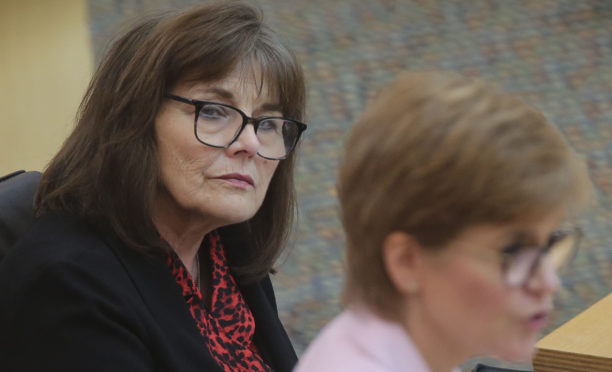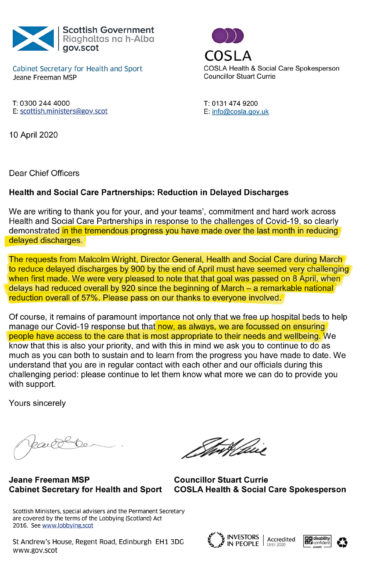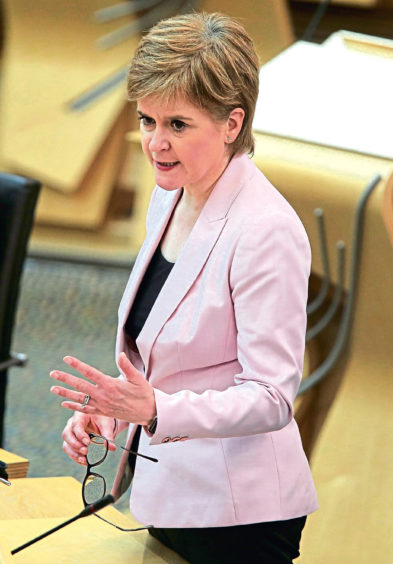
A leaked letter from Health Secretary Jeane Freeman has revealed the pressure put on hospitals to send elderly patients into care homes in the weeks before and after lockdown.
In the letter to health boards, dated April 10, Ms Freeman praises them for surpassing “challenging” targets as the NHS prepared for an onslaught of Covid patients.
However, hundreds of patients were sent into care homes untested and the Scottish Government has come under sustained pressure since we revealed last week how dozens were transferred into homes despite testing positive. Critics of the policy have described it as “putting a match to tinder” in homes where almost 2,000 residents were to die in the pandemic.
The letter from Ms Freeman to NHS bosses reveals they had been asked to hit a target of clearing 900 delayed discharges out of hospital by the end of April before she goes on to thank them for making “tremendous progress” after they moved 920 patients out by April 8.
The “challenging” target cited in the letter can be revealed today, days after First Minister Nicola Sturgeon denied ministers had been involved in the process and insisted it was the responsibility of hospitals and councils to make individual clinical decisions. She added: “The responsibility of ministers is to put in place guidance.”
The request to reduce delayed discharges by the end of April must have seemed very challenging. You have made tremendous progress – HEALTH SECRETARY, APRIL 10
However, Dr Lewis Morrison, chairman of doctors union BMA Scotland, said: “The responsibility for hospital discharge to the community is a complex mix of multidisciplinary clinical decision-making, NHS and local authority management of delayed discharges and, of course, Scottish Government policy and directives.
“At the beginning of the pandemic, decisions were taken and funding made available to facilitate a more urgent reduction in the numbers of patients delayed in hospital awaiting complex care or care home placement, to free up capacity for an anticipated but unknown major peak of Covid-19 admissions.”
Ms Freeman and Cosla’s health spokesman, the SNP councillor Stuart Currie, wrote to Scotland’s health and social care partnerships, involving health boards and local authorities, to thank them for their efforts in clearing beds.
Their letter said: “The requests from Malcolm Wright, Director General, Health and Social Care, during March to reduce delayed discharges by 900 by the end of April must have seemed very challenging when first made.
“We were very pleased to note that that goal was passed on April 8, when delays had reduced overall by 920 since the beginning of March – a remarkable national reduction overall of 57%. Please pass on our thanks to everyone involved.”
Ms Freeman’s letter goes on to urge NHS bosses to continue to clear hospital beds but says the needs of patients must be the priority. It states: “Of course, it remains of paramount importance not only that we free up hospital beds to help manage our Covid-19 response but that now, as always, we are focused on ensuring people have access to the care that is most appropriate to their needs and wellbeing.
Ministers do not know the individual clinical decisions that are taken in cases of patients being discharged from hospital. The responsibility of ministers is to put in place guidance – FIRST MINISTER, AUGUST 20
“We know that this is also your priority, and with this in mind we ask you to continue to do as much as you can both to sustain and to learn from the progress you have made to date.”
Official statistics show almost 2,000 deaths linked to coronavirus happened in care homes, almost half of Scotland’s toll so far, despite just 1% of the population living there.
Nick Kempe, a former Glasgow City Council head of services for older people, wrote a report on the coronavirus crisis in care homes for think tank Common Weal. He said: “The average consultant would not have much idea of how good care homes were at infection control in general, let alone whether a specific home was capable of providing care to an infected person while ensuring the virus did not spread to anyone else. Those issues are outwith their remit.
“The Health Secretary’s letter shows the Scottish Government put enormous pressure on hospitals to discharge patients. The letter also said it remains of paramount importance to free up hospital beds. There is no mention of risk here at all and it appears clear that any consideration of risk was secondary to the paramount importance of getting people out of hospitals.
“That explains how infected people were sent into care homes, and this is where responsibility lies for a large proportion of deaths.”
Labour MSP for the Lothians Neil Findlay said: “Despite the First Minister telling parliament that clinicians were solely responsible for decisions about moving patients out of hospitals, ministers were clearly involved in setting targets. It was a policy decision.
“Many of those who left hospital ended up in care homes and we now know that some had tested positive for coronavirus. Why was there no discussion about the risk this policy posed to vulnerable residents? These are questions that the Health Secretary and First Minister must answer in parliament.”
Scottish Labour leader Richard Leonard said: “This letter confirms in black and white that SNP politicians were driving this policy. The First Minister can no longer try to deflect responsibility on to clinicians. Having failed to make good on its promise to end delayed discharge in 2015, the SNP Government then allowed thousands of patients to be transferred to care homes without being tested – or as was revealed last week even after testing positive for Covid-19.”
Donald Cameron, Scottish Conservative health spokesman, said: “Jeane Freeman’s letter contains some very concerning statements that the Health Secretary must clear up immediately.
“While the need to free up hospital capacity at the start of this crisis was understandable, there was clearly a considerable amount of pressure put on NHS boards to move patients as quickly as possible,” he added. “This is precisely why we need an urgent public inquiry to uncover exactly what happened with Covid patients being transferred to care homes.”
Alex Cole Hamilton, Liberal Democrat health spokesman, said: “Right out of the trap, the SNP have tried to blame clinicians for the tragedy in our care homes, yet now we know that they had hospitals under the cosh to deliver a target.”
The First Minister has promised a public inquiry but she has refused to set a date, saying it would distract from the fight against Covid despite experts warning lessons must be learned before a possible second wave of the virus hits Scotland.
GMB Scotland Secretary Gary Smith, whose trade union represents carers, said: “There has to be accountability and transparency surrounding these events.”
The First Minister was questioned repeatedly about the policy at Holyrood on Thursday. She said she could not take her responsibilities any more seriously and apologised if mistakes had been made.
However, she said, when the moves were made to clear beds in the weeks before and after lockdown in March there were concerns the NHS would buckle under Covid and, she said, it was believed elderly patients might be safer in care than in hospitals.
The Scottish Government yesterday said: “Any decision on whether a patient is ready for discharge is a clinical decision, made by the clinician in charge. These decisions are not made by ministers, they are made by health and social care professionals, alongside the patient and their family members.
“There has never been guidance or policy to actively move patients unwell with Covid-19 into care homes. Any individual being placed in a care home must be subject to an appropriate risk assessment and be isolated for 14 days.”
It added a public inquiry has been promised into all aspects of the Scottish Government’s response but the immediate focus is on tackling the ongoing crisis.
Timeline of a catastrophe
Early March
Hospitals begin transferring delayed discharge patients to care homes to free up beds and staff amid fears NHS cannot cope with Covid onslaught.
March 13
New guidance is issued to care homes to ensure all residents are looked after in their own rooms, and that appropriate infection prevention and control measures were in place.
April 4
Thirteen residents at Burlington Court, a Glasgow care home, die in one week after a coronavirus outbreak there.
April 10
Health Minister Jeane Freeman writes to health and social care partnerships to thank them for their success in transferring 920 delayed discharge patients out of hospitals.
April 15
Amid growing alarm over deaths in care homes, Nicola Sturgeon says care home residents matter “every bit as much” in the fight against coronavirus.
April 21
Testing of hospital patients before they can be discharged to a care home becomes mandatory.
June 3
Figures show more people have died in care homes than hospitals, with 1,818 deaths in homes, compared with 1,815 in hospitals.

Enjoy the convenience of having The Sunday Post delivered as a digital ePaper straight to your smartphone, tablet or computer.
Subscribe for only £5.49 a month and enjoy all the benefits of the printed paper as a digital replica.
Subscribe © u204459
© u204459 © PA
© PA